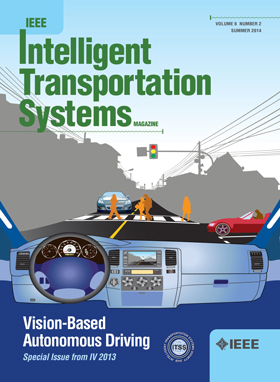LiDAR-BEVMTN: Real-Time LiDAR Bird’s-Eye View Multi-Task Perception Network for Autonomous Driving
IF 7.9
1区 工程技术
Q1 ENGINEERING, CIVIL
IEEE Transactions on Intelligent Transportation Systems
Pub Date : 2025-01-10
DOI:10.1109/TITS.2024.3510642
引用次数: 0
Abstract
LiDAR is crucial for robust 3D scene perception in autonomous driving. LiDAR perception has the largest body of literature after camera perception. However, multi-task learning across tasks like detection, segmentation, and motion estimation using LiDAR remains relatively unexplored, especially on automotive-grade embedded platforms. We present a real-time multi-task convolutional neural network for LiDAR-based object detection, semantics, and motion segmentation. The unified architecture comprises a shared encoder and task-specific decoders, enabling joint representation learning. We propose a novel Semantic Weighting and Guidance (SWAG) module to transfer semantic features for improved object detection selectively. Our heterogeneous training scheme combines diverse datasets and exploits complementary cues between tasks. The work provides the first embedded implementation unifying these key perception tasks from LiDAR point clouds achieving 3ms latency on the embedded NVIDIA Xavier platform. We achieve state-of-the-art results for two tasks, semantic and motion segmentation, and close to state-of-the-art performance for 3D object detection. By maximizing hardware efficiency and leveraging multi-task synergies, our method delivers an accurate and efficient solution tailored for real-world automated driving deployment. Qualitative results can be seen at激光雷达对于自动驾驶中稳健的三维场景感知至关重要。激光雷达感知的文献数量仅次于摄像头感知。然而,使用激光雷达进行检测、分割和运动估计等任务的多任务学习仍相对欠缺,尤其是在汽车级嵌入式平台上。我们提出了一种实时多任务卷积神经网络,用于基于激光雷达的物体检测、语义和运动分割。该统一架构由共享编码器和特定任务解码器组成,实现了联合表示学习。我们提出了一个新颖的语义加权和引导(SWAG)模块,用于转移语义特征,从而有选择性地改进物体检测。我们的异构训练方案结合了不同的数据集,并利用了任务之间的互补线索。这项工作提供了首个嵌入式实施方案,在嵌入式英伟达 Xavier 平台上实现了 3 毫秒的延迟,统一了来自激光雷达点云的这些关键感知任务。我们在语义和运动分割这两项任务上取得了最先进的结果,在三维物体检测方面也接近最先进的性能。通过最大限度地提高硬件效率和利用多任务协同效应,我们的方法为现实世界的自动驾驶部署提供了准确高效的解决方案。定性结果见 https://youtu.be/H-hWRzv2lIY。
本文章由计算机程序翻译,如有差异,请以英文原文为准。
求助全文
约1分钟内获得全文
求助全文
来源期刊

IEEE Transactions on Intelligent Transportation Systems
工程技术-工程:电子与电气
CiteScore
14.80
自引率
12.90%
发文量
1872
审稿时长
7.5 months
期刊介绍:
The theoretical, experimental and operational aspects of electrical and electronics engineering and information technologies as applied to Intelligent Transportation Systems (ITS). Intelligent Transportation Systems are defined as those systems utilizing synergistic technologies and systems engineering concepts to develop and improve transportation systems of all kinds. The scope of this interdisciplinary activity includes the promotion, consolidation and coordination of ITS technical activities among IEEE entities, and providing a focus for cooperative activities, both internally and externally.
 求助内容:
求助内容: 应助结果提醒方式:
应助结果提醒方式:


